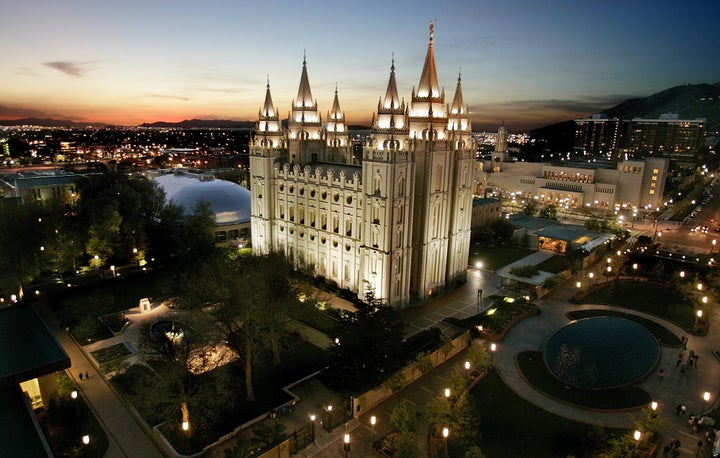
The corner of the internet concerned with Mormon issues has been aflutter recently over a new ad campaign created by the Church of Jesus Christ of Latter-day Saints, featuring profiles of church members, showcasing their achievements, their individuality, their likability. It turns out that Mormons can be professional surfers and talented skateboarders. Having grown up Mormon in a small Mormon town, I've long appreciated the complexity of Mormon character and the uniqueness of individual Mormons, and I'm totally down with a project to reveal that to the rest of the world. I just wish the church hadn't spent the last three decades encouraging, if not demanding, homogeneity and blandness -- or, to use the official LDS term for the virtue of uniformity, correlation.
Originated in the early twentieth century but not emphasized until the 1970s, correlation was a program that consolidated central control and enforced consistency and sameness as much as possible throughout the church. Divisions within the church that had previously enjoyed considerable autonomy, such as the women's organization known as Relief Society (because its good works offered relief to those who suffered), were required to surrender independent local and church-wide bank accounts to authorities in Salt Lake City. Basic floor plans were created for temples and meeting houses, so that every place of worship built by the LDS church would resemble all others. Some more distinctive and eccentric buildings were bulldozed or sold, to the heartbreak of members who used them. Other design elements were also standardized: the church chose an official font for its logo, to be used on everything from missionary name tags to the signs outside churches.
When I was a child my father loved teaching Sunday school; each year he received a newly written manual full of challenging lessons requiring careful preparation if one was to teach them well. That ended with correlation; curricula were simplified and standardized for every age group and congregation. All lesson manuals were designed to be basic enough that virtually anyone could teach them; they were cross-checked for consistency, and approved by high-level authorities, to avoid controversy and ensure orthodoxy, even among three-year-olds. The results are what you'd expect. As Jana Riess notes in her blog Flunking Sainthood, Mormons go to church "to learn about God, not to worship God," and their meetings are so dull they are "stultifying."
Even appearance, dress and grooming were correlated, down to the color of men's dress shirts (white), the length of men's hair (above the collar), and the number of earrings worn by women (one in each lobe). Of course there were Mormons who dressed and groomed themselves as they pleased, but that didn't change the explicit directives informing members that to demonstrate obedience and worthiness, they would cultivate a modest, conservative appearance, as anything else suggested a proud, defiant heart.
So the new ads, challenging the effects of correlation, are overdue. However, they're not perfect. First, while profiles might feature hipsters with trendy clothes, the opinions and beliefs in a profile must be completely orthodox and thoroughly respectful, or it will be rejected by the site.
Second, as ECS of Feminist Mormon Housewives notes, there's a bait and switch going on in the profiles of women: most featured profiles showcase "women with small children who choose to work outside the home in demanding careers," which is not the ideal Mormon women are told to aspire to -- instead, they're encouraged to be stay-at-home-moms whenever possible. ECS concludes that if the church doesn't address the discord between what it tells its own members Mormon families should be like, and what it tells the rest of the world Mormon families are like, then "this PR campaign is disingenuous at best, and just plain gross, at worst."
Finally, the ads simply won't fix a primary problem they're designed to address: the church's dreadful image.
People think badly of the Mormon church not because they don't like its members, but because they don't like its policies, practices and teachings. Demonstrating to the world that individual Mormons are interesting, thoughtful, likable people won't compensate for the corporate church's vendetta against the queer community, its assault on women's rights, its history of racism, its polygamous past (or the fact that polygamy remains a central tenet of Mormon doctrine, even today), its odd doctrines (such as the belief that God is a resurrected man who lives near the planet Kolob) and its most arrogant practices (such as baptizing everyone's ancestors into the Mormon faith after they die, and trying to convert everyone else while they're still alive). In that list, there's something to offend just about everyone who isn't already Mormon -- and even many Mormons are outraged and hurt by the church's aggressive opposition to civil rights.
Imagine a similar campaign from BP, with a website introducing you to its lower-level employees. They surf, they skateboard, they volunteer in their communities. They're well-educated and well-spoken. They're clean but not scrubbed. You'd be happy living next door to them. The fact that BP's employees are decent, likable people doesn't change the fact that their employer, the entity footing the bill for the whole endeavor, is also the organization that trashed the Gulf of Mexico in an oil spill that killed 11 workers and untold marine life. If you care at all about the environment and corporate accountability, you'd still be leery of BP, its policies, its statements, and you wouldn't really want to get a job there or even buy its products.
The same is true for Mormonism. People can see this very polished PR campaign for what it is, and while it might improve the image of individual Mormons, it won't do a thing to burnish the image of the corporate church.